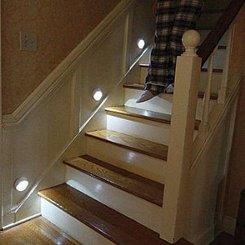Motion-activated path lights combine the technology of an occupancy sensor with high output, low consumption LED lights. Path lights can be hardwired with a low voltage power source or battery powered for flexible design and ease of installation. In each case, occupancy sensing or motion-activated path lights are convenient way to add useful lighting to a space while saving
energy.
Path lights are specifically designed to light up dark corridors or stairwells which rarely see natural light, even in the daytime. Rather than wiring extra light fixtures to light these areas and inconvenience with you with light switches which we tend to leave on when not needed, occupancy sensing pathlights will turn themselves on or off when needed and not needed. This is not only a luxury but also a safety feature to add to your home or backyard. Consider how many times you find yourself shuffling around in a dark hallway looking for a light switch. With motion-activating path lights there is no need to dangerously walk around un-lit stairwells anymore.
Motion-activating path lights also add a modern and futuristic look that is sure to blend in with and spice up even the most conventional decor. Here are several examples of where you can use occupancy sensing path lights to add convenience, safety, and luxury to your living spaces.
1. Stairwell or Hallway- Of course, this is the most popular use for occupancy sensing pathlights. Path lights will turn on one by one as an occupant ascends or descends your dark hallway. This safety feature looks luxurious and is sure to add flare to an otherwise boring space.
2. Outdoor stairs- Outdoor pathways often include stairs to adjust elevation changes in the terrain. These stairs are often trip hazards in areas that are not always lit. Trust motion-activated path lights on each riser to detect an occupant when he or she is six feet away and light up the stairs.
3. Under Cabinet Lighting- Install motion activated path lights in your kitchen to light up shaded work spaces under your upper wall cabinets. This alternative to traditional LED under cabinet lighting can save even more energy and look even cooler as it lights up only the counter top space that you are using.
4. Gallery lighting- Add an extra dimension to the artwork in your home. As occupants walk by to observe hanging artwork a motion activated path light mounted over your painting or series of paintings is sure to draw them in and bring your artwork to life.
5. Closet spotlights- Closets in older homes and even some newer homes are rarely wired for lighting. And if they are, occupants are constantly leaving the closet light on! Never leave the closet light on again with occupancy sensing path lights over each section of clothing. This will make getting up and picking out your clothes fun and easier than ever.
energy.
Path lights are specifically designed to light up dark corridors or stairwells which rarely see natural light, even in the daytime. Rather than wiring extra light fixtures to light these areas and inconvenience with you with light switches which we tend to leave on when not needed, occupancy sensing pathlights will turn themselves on or off when needed and not needed. This is not only a luxury but also a safety feature to add to your home or backyard. Consider how many times you find yourself shuffling around in a dark hallway looking for a light switch. With motion-activating path lights there is no need to dangerously walk around un-lit stairwells anymore.
Motion-activating path lights also add a modern and futuristic look that is sure to blend in with and spice up even the most conventional decor. Here are several examples of where you can use occupancy sensing path lights to add convenience, safety, and luxury to your living spaces.
1. Stairwell or Hallway- Of course, this is the most popular use for occupancy sensing pathlights. Path lights will turn on one by one as an occupant ascends or descends your dark hallway. This safety feature looks luxurious and is sure to add flare to an otherwise boring space.
2. Outdoor stairs- Outdoor pathways often include stairs to adjust elevation changes in the terrain. These stairs are often trip hazards in areas that are not always lit. Trust motion-activated path lights on each riser to detect an occupant when he or she is six feet away and light up the stairs.
3. Under Cabinet Lighting- Install motion activated path lights in your kitchen to light up shaded work spaces under your upper wall cabinets. This alternative to traditional LED under cabinet lighting can save even more energy and look even cooler as it lights up only the counter top space that you are using.
4. Gallery lighting- Add an extra dimension to the artwork in your home. As occupants walk by to observe hanging artwork a motion activated path light mounted over your painting or series of paintings is sure to draw them in and bring your artwork to life.
5. Closet spotlights- Closets in older homes and even some newer homes are rarely wired for lighting. And if they are, occupants are constantly leaving the closet light on! Never leave the closet light on again with occupancy sensing path lights over each section of clothing. This will make getting up and picking out your clothes fun and easier than ever.

 RSS Feed
RSS Feed